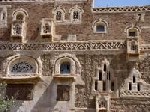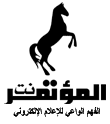 Almotamar Net
Almotamar Net - The article started by an introduction on certain decoration found on several Yemeni-Islamic buildings, and their importance within the study of the Islamic arts.
Then the text of the article started in stating that there are some elements of decorations visible on Yemen's Islamic architecture which clearly had its precedence of the pattern of Islamic art right from the birth of Islam.
This pattern is exposed through the various forms of botanical, engineering and written decorations. Those are considered the three main elements to concentrate on the religious buildings constructed within the structure of Islamic patterns.
Besides, there are other decorations of human and animal features, such as the drawing of birds facing each other to be found on the external walls of the "Big Mosque" of Sana'a. Such clearly engravings of bird scenery is quite known in the field of Islamic arts.
On first sight by the researcher or viewer to Yemen's architectural archeology, the "Kufi" writing looks clearly visible within both its first and later stages of development. The foundation wall-faces of Sana'a "Big Mosque" illustrate the pattern of this writing been adaptable in the second Hijria century (eight century A.D.). It also shows the "Kufi" wirting style, which in-turn expresses its perfection, or accuracy, from the technical point of view on one hand, and its adoption through the engraving-stone writings on the other. Here, it is also possible to associate it; in respect of the subjective and artistic points of view; with the foundation portraits found attached to the Islamic patterns of the religious buildings related to other Arab countries.
Another illustration of the "Kufi" writing; that had technically developed during the fourth and fifth Hijria centuries (tenth and elementh A.D.); can be found on the wooden supporting-stands of the small-sized Quranic documents placed in the praying halls of Yemeni mosques e.g. Al-Hadi-ill AlHaq mosque in Sa'adah, which verify the development of the writing and the adaptability of the artists. Moreover, there are many other examples of Arabic writings been shown in their splendid patterns and variations of the kinds, which to be found in both Yemen and the Arab world. All such writings give an indication of Yemeni capability to be adapted with the changing patterns that regularly developed during the Islamic world.
For enriching the field of Islamic archeological inscriptions, there is a need for their studies and treatment in more academic forms and ways. This is because of their context which constituted several aspects, such as the presence of many verses of the Holly Quran, sentences of prayers to God and dates of establishing buildings Moreover, they are more distinguished in Yemen when compared elsewhere by the fact of having a more enlarged and enriched wealth of language that had expressed certain horizons of culture and intellect.
This is very rarely visible in other Islamic archeology of similar patterns. Thus, Yemeni linguistic formation ought to undergo more research and studies in order to find the connecting link between it and the others of the Arab world.
Next to the written inscriptions, there are many gypsum-powdered decorations, which are almost everywhere found on the Islamic monuments in Yemen, either in the formation of the mosques' shrines, or on the walls of Yemeni-Islamic teaching schools. Such botanical decorations were the product of the Yemeni artist, or maker; being transferred from the hands of one generation to another; throughout the historical ages. It had a wide devoting of many people, due to the abundant wealth of such decorations on these Islamic archeological buildings.
The examples are many as one may see in the form of architectural blocks made of the gypsum been decorated by stripped-lines of writings that proceed along a series of patterns around the main front shrines. It is usually placed at the middle taking the shape of a hollow arch of a semi-circular, or, end-pointed shapes. Sometimes, it may take the shape of a pearled chain, when it becomes similar to those found in the old Islamic Empire of Spain.
In many parts on these blocked; constituting Yemen's gypsum-powdered shrines; one may notice the "Arabsic" decoration.
These are plant-like decoration wit very concentrated elements of round shaping, which had prospered during the sixth Hijria century. Its style was again continued with more advanced progress during the seventh and eight centuries (13th and 14th centuries A.D.). They are more apparent on the upper coaching levels of the arches related to these gypsum shrines. Due to the very scrutinized style of industrial craftsmanship, such decorations deserve a detailed study from the archeological aspect of the subject.
The decoration on the timber structures found inside many civil and religious buildings in Yemen also deserve a scientific thorough study. These timber lengths that have visibly engraved sculptures are fixed as the structural supports of the main pray halls of Yemeni mosques. It is well known here that such wooden structures inside the mosques, and; in particular on the burial tombs of the saints found in or around the areas of such mosques; are considered part of the fields of archeological studies respective to the style of decoration. They form a kind of an existing pattern found in all Yemeni and other Arab origins. They have had various changes that developed along the same kind of changes that occurred through the Islamic ages on the industrial pattern of the timber, and its decoration in general, but more particularly in Yemen than any where else.
Moreover, it is worth noting that the pattern of decoration on Yemeni wood structures can also be traceable on the front entrances of old Yemeni houses. Such pattern and style do carry some paragraphs of publicity; as well as; botanical and technical aspects of decoration. Actually, it constituted an important addition in the field of wood decoration treatment within the Islamic art. Again, other residences have metallic doors that also have had various forms of decoration. On the other hand, some old Islamic schools and mosques contain peculiar technical pieces of decorative designs; together with; their dates of origin, or, manufacture labeled on them. All these can help a lot in initiating a thorough study of the decorations on the Islamic timber structures.
On the other hand, the pillars and constructional supports are also among the architectural and decorative elements found in the Islamic buildings. These constitute
another subject noticeable about Islamic archeology in Yemen. In fact, most of these embody the Islamic pattern placeable on every pillar, either on the decorative style of its upper "throne" structural-part, or all around its body.
A study on this aspect may add a new scientific contribution to the field of Islamic archeology.
It is important, too, to point out the water decoration pattern (liquid form of drawings) found on the interior portion of the domes placed usually on the top surfaces of such Yemeni archeological buildings; as well as; on the walls of some mosques. This had been done by Yemeni artists through the work of drawing with the use of liquid-coloring elements on the layers of the gypsum before it had been hardened. This type of painting can be clearly viewed on many hollow and interior sections of the domes and arches related to Yemen's archeological architecture. It had been conducted through following certain known principles related to this field. Such decoration largely carried several decorative designs well adaptable to the art of the Islamic ages. Thus, it is worth to have a link that may associate it with the other Islamic monuments found in the Islamic world. This is because liquid form of designing was known in Yemen at the early phase of Islamic to form part of the Islamic arts, which were viewed particularly on the civilian houses and residences. It had since then spread and continued for many centuries in compliance with specific and certain directives closely related to the field arts.
___________________________________
Source: "Maeen" periodical, issue No. 58 of 1990
A published review of an article on Islamic
Studies in Yemen
Author: Dr. Mustafa Abdulla Sheikha

